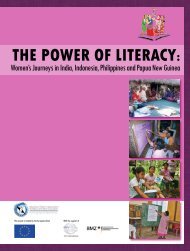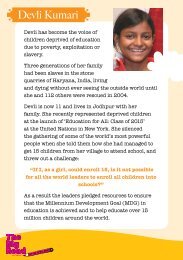Gender Discrimination in Education: The violation of rights of women ...
Gender Discrimination in Education: The violation of rights of women ...
Gender Discrimination in Education: The violation of rights of women ...
You also want an ePaper? Increase the reach of your titles
YUMPU automatically turns print PDFs into web optimized ePapers that Google loves.
PART 1: Introduction<br />
1. <strong>The</strong>re are multiple and diverse l<strong>in</strong>ks between gender<br />
equality and the fulfillment <strong>of</strong> the human right to<br />
education. <strong>The</strong> pervasive denial <strong>of</strong> the human right<br />
to education experienced by <strong>women</strong> and girls across<br />
the globe – as shown, for example, by the fact that two<br />
thirds <strong>of</strong> the world’s non-literate adults are <strong>women</strong> – is a<br />
strik<strong>in</strong>g example <strong>of</strong> gender discrim<strong>in</strong>ation. <strong>Education</strong> is<br />
an enabl<strong>in</strong>g and transformative right. As po<strong>in</strong>ted out by<br />
the Committee on Economic, Social and Cultural Rights<br />
(CESCR), the right to education “has been variously<br />
classified as an economic right, a social right and a<br />
cultural right. It is also a civil right and a political right,<br />
s<strong>in</strong>ce it is central to the full and effective realization <strong>of</strong><br />
those <strong>rights</strong> as well. In this respect, the right to education<br />
epitomizes the <strong>in</strong>divisibility and <strong>in</strong>terdependence <strong>of</strong> all<br />
human <strong>rights</strong>” i . A strong education system, <strong>in</strong> l<strong>in</strong>e with<br />
the pr<strong>in</strong>ciple <strong>of</strong> non-discrim<strong>in</strong>ation, is key for redress<strong>in</strong>g<br />
gender <strong>in</strong>justice <strong>in</strong> wider society, and for overcom<strong>in</strong>g<br />
social and cultural norms that discrim<strong>in</strong>ate aga<strong>in</strong>st girls<br />
and <strong>women</strong>. CESCR has also clearly stated that “the<br />
prohibition aga<strong>in</strong>st discrim<strong>in</strong>ation enshr<strong>in</strong>ed <strong>in</strong> article<br />
2 <strong>of</strong> the Covenant [<strong>of</strong> Economic, Social and Cultural<br />
Rights] is subject to neither progressive realization<br />
nor the availability <strong>of</strong> resources; it applies fully and<br />
immediately to all aspects <strong>of</strong> education and encompasses<br />
all <strong>in</strong>ternationally prohibited grounds <strong>of</strong> discrim<strong>in</strong>ation”.<br />
<strong>The</strong> Global Campaign for <strong>Education</strong> (GCE) therefore<br />
sees the challenge posed by gender discrim<strong>in</strong>ation <strong>in</strong><br />
education as multiple: policy and practice <strong>in</strong> education<br />
needs to be re-oriented to ensure the deconstruction <strong>of</strong><br />
gender stereotypes as well as the promotion <strong>of</strong> equality<br />
<strong>of</strong> experience and relations for both sexes <strong>in</strong> education,<br />
thus address<strong>in</strong>g power imbalances that perpetuate gender<br />
<strong>in</strong>equality and leverag<strong>in</strong>g access to all <strong>rights</strong> by woman<br />
and girls.<br />
2. <strong>Education</strong> is strongly embedded <strong>in</strong> CEDAW, <strong>in</strong><br />
ways that reflect this rich relationship between gender<br />
equality and the right to education. CEDAW article 10<br />
explicitly enshr<strong>in</strong>es the right to equality <strong>in</strong> education,<br />
while many other articles – notably 5 (on social and<br />
cultural norms), 7 (on civil and political participation), 8<br />
(on <strong>in</strong>ternational representation), 11 (on employment),<br />
14 (on the social, economic and cultural <strong>rights</strong> <strong>of</strong> rural<br />
<strong>women</strong>) and 16 (on <strong>rights</strong> to and with<strong>in</strong> marriage, and<br />
<strong>women</strong>’s reproductive <strong>rights</strong>) – express <strong>rights</strong> <strong>of</strong> which the<br />
full realization is very strongly dependent on address<strong>in</strong>g<br />
gender discrim<strong>in</strong>ation <strong>in</strong> education. Moreover, CEDAW’s<br />
General Recommendation 3, as well as article 10 <strong>of</strong> the<br />
ma<strong>in</strong> convention, expresses clearly the role <strong>of</strong> education<br />
<strong>in</strong> address<strong>in</strong>g wider gender discrim<strong>in</strong>ation based on<br />
stereotyp<strong>in</strong>g and biased cultural norms.<br />
3. <strong>The</strong> human right to education and nondiscrim<strong>in</strong>ation<br />
is further affirmed by a number <strong>of</strong><br />
other <strong>in</strong>ternational treaties. Along with the clear<br />
expression <strong>of</strong> a universal right to education <strong>in</strong> Article 26<br />
<strong>of</strong> the Universal Declaration <strong>of</strong> Human Rights, and the<br />
provisions on gender-equitable education <strong>in</strong> CEDAW, the<br />
most significant expressions <strong>of</strong> these <strong>rights</strong> are found <strong>in</strong><br />
the Convention on the Rights <strong>of</strong> the Child (CRC, 1989),<br />
the International Covenant on Economic, Social and<br />
Cultural Rights (ICESCR, 1966) and the 1960 UNESCO<br />
Convention aga<strong>in</strong>st <strong>Discrim<strong>in</strong>ation</strong> <strong>in</strong> <strong>Education</strong>.<br />
Governments further committed themselves to ensur<strong>in</strong>g<br />
gender equality <strong>in</strong> education <strong>in</strong> the Dakar Framework<br />
for Action (2000), the Millennium Development Goals<br />
(2000), the Beij<strong>in</strong>g Declaration and Platform for Action<br />
(1995) and the World Declaration on <strong>Education</strong> For All<br />
(1990), which stated that “the most urgent priority is to<br />
ensure access to, and improve the quality <strong>of</strong>, education<br />
for girls and <strong>women</strong>, and to remove every obstacle<br />
that hampers their active participation.” Yet despite<br />
these numerous treaties, States and the <strong>in</strong>ternational<br />
community still largely treat education as a development<br />
goal and not as a right. GCE believes that a clear<br />
<strong>rights</strong>-based understand<strong>in</strong>g <strong>of</strong> education is crucial to<br />
overcom<strong>in</strong>g gender discrim<strong>in</strong>ation and to re-orient<strong>in</strong>g<br />
education towards the promotion <strong>of</strong> greater gender<br />
equality <strong>in</strong> society as a whole.<br />
4. <strong>The</strong>re has been undeniable progress made <strong>in</strong><br />
improv<strong>in</strong>g gender parity <strong>in</strong> education <strong>in</strong> the three<br />
decades s<strong>in</strong>ce the entry <strong>in</strong>to force <strong>of</strong> CEDAW. Parity <strong>in</strong><br />
enrolment has accelerated over the 22 years s<strong>in</strong>ce the first<br />
agreement <strong>of</strong> the <strong>Education</strong> For All framework <strong>in</strong> Jomtien,<br />
and s<strong>in</strong>ce agreement <strong>of</strong> the Millennium Development<br />
Goals <strong>in</strong> 2000. <strong>The</strong> number <strong>of</strong> girls out <strong>of</strong> school fell<br />
by more than 40% from 1999 to 2008 ii , and girls now<br />
constitute 53% <strong>of</strong> those children out <strong>of</strong> school, as opposed<br />
to 60% at the start <strong>of</strong> the millennium. <strong>The</strong> MDGs called<br />
for gender parity at primary and secondary education by<br />
2005, a target that was clearly missed; nevertheless, it is<br />
encourag<strong>in</strong>g that at an aggregate level, the world is now<br />
closer to achiev<strong>in</strong>g gender parity, at least so <strong>in</strong> primary<br />
education.<br />
5. Progress on enrolment, however, should not mask the<br />
fact that girls and <strong>women</strong> cont<strong>in</strong>ue to be denied their<br />
<strong>rights</strong> throughout the education cycle, and still face<br />
huge discrim<strong>in</strong>ation and disadvantage <strong>in</strong> terms <strong>of</strong> access,<br />
progress, learn<strong>in</strong>g and their experience <strong>in</strong> schools. <strong>The</strong><br />
target <strong>of</strong> achiev<strong>in</strong>g gender parity <strong>in</strong> school enrolments<br />
ga<strong>in</strong>ed significant traction <strong>in</strong> the <strong>in</strong>ternational community<br />
not least because <strong>of</strong> its <strong>in</strong>clusion <strong>in</strong> the Millennium<br />
Development Goals (MDGs). But the consequent<br />
progress has led to a dangerous complacency about the<br />
reduction <strong>of</strong> gender <strong>in</strong>equality <strong>in</strong> education. Girls are still<br />
far more likely to drop out before complet<strong>in</strong>g primary<br />
education, have markedly worse experience <strong>in</strong> school,<br />
<strong>of</strong>ten characterized by violence, abuse and exploitation,<br />
and have scant chance <strong>of</strong> progress<strong>in</strong>g to secondary school<br />
and tertiary education. <strong>The</strong> prelim<strong>in</strong>ary f<strong>in</strong>d<strong>in</strong>gs <strong>of</strong><br />
GCE’s global survey <strong>of</strong> gender <strong>in</strong> schools show that more<br />
than one fifth <strong>of</strong> girls <strong>in</strong> secondary schools are unhappy<br />
3<br />
<strong>Gender</strong> <strong>Discrim<strong>in</strong>ation</strong> <strong>in</strong> <strong>Education</strong>: <strong>The</strong> <strong>violation</strong> <strong>of</strong> <strong>rights</strong> <strong>of</strong> <strong>women</strong> and girls
















